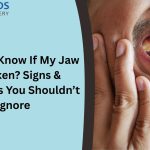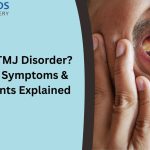Facial trauma is a serious medical concern, and one of the most commonly injured facial bones is the cheekbone, also known as the zygomatic bone. While minor injuries may heal on their own, fractures require prompt diagnosis and treatment. Patients often ask me, “What are the symptoms of cheekbone fracture that should alert me to see a doctor?” In this guide, I will outline the top warning signs, the diagnostic process, and when to seek immediate care.
As a specialist in facial trauma and TMJ treatment in India, I’ve treated numerous patients with facial fractures—many of whom delayed seeking treatment because the signs were subtle at first. Early recognition is key to avoiding long-term issues such as facial asymmetry, nerve damage, and jaw dysfunction.
What is a Cheekbone Fracture?

A cheekbone fracture involves the break or displacement of the zygomatic bone, which connects to the eye socket, upper jaw, and temporal bone. Due to this interconnected anatomy, a fracture can impact vision, jaw movement, and facial appearance. That’s why identifying symptoms of cheekbone fracture early is critical.
1. Swelling Around the Cheek or Eye
The most immediate and visible symptom of cheekbone fracture is facial swelling. It may extend to the lower eyelid or temple. The affected area might feel tender, warm, and unusually firm.
2. Bruising and Discoloration
Another classic sign is bruising under the eye (periorbital ecchymosis), on the cheek, or in the upper gum region. These symptoms of cheekbone fracture indicate internal bleeding or trauma beneath the skin.
3. Numbness or Tingling
The cheekbone area houses the infraorbital nerve. When this nerve is compressed or damaged due to a fracture, it can lead to numbness in the upper lip, cheek, or side of the nose.
Patients often report a pins-and-needles sensation—one of the lesser-known but important symptoms of cheekbone fracture.
4. Blurred or Double Vision
Because the cheekbone forms part of the eye socket, any displacement can affect eye alignment. Patients may notice blurred or double vision, difficulty moving the eye, or a sunken appearance.
These symptoms require immediate imaging and assessment.
5. Jaw Pain or Difficulty Opening the Mouth
The zygomatic bone is closely linked with jaw function. When fractured, it can impact the movement of the mandible, causing pain while chewing or talking. This overlaps with TMJ disorders, and in many cases, we assess for both.
That’s why facilities offering TMJ treatment in India are well-equipped to evaluate and treat such injuries comprehensively.
6. Flattening of the Cheek
A subtle but significant symptom of cheekbone fracture is loss of cheek contour. The cheek on one side may appear flatter or sunken, altering facial symmetry.
This is often overlooked until swelling subsides, but early detection can prevent permanent disfigurement.
7. Clicking or Grinding Sound When Moving the Jaw
Some patients hear or feel a clicking sound near the ear or cheek while chewing. This can result from dislocated bone fragments interfering with joint motion.
It’s one of the mechanical symptoms of cheekbone fracture that signals deeper skeletal involvement.
What Causes a Cheekbone Fracture?
Common causes include:
- Falls or sports injuries
- Physical assault
- Road traffic accidents
- Industrial or workplace trauma
- High-impact activities like biking or climbing
Bone health conditions such as osteoporosis may increase fracture risk even with minor trauma.
Diagnostic Process
When a patient presents with symptoms of cheekbone fracture, the diagnostic steps typically include:
- Clinical Examination: Assessing facial asymmetry, eye movement, and jaw function
- X-ray or OPG: To detect initial displacement
- CT Scan: Provides a detailed 3D image of the cheekbone and surrounding structures
At our center for TMJ treatment in India, we integrate 3D imaging and digital modeling for precise diagnosis and surgical planning.
Treatment Options
1. Non-Surgical Management
- Mild, non-displaced fractures may heal with rest, ice application, and anti-inflammatory medications
- Patients are advised to avoid pressure or strenuous jaw activity
2. Surgical Intervention
- Open reduction and internal fixation (ORIF)
- Titanium plate and screw placement
- Repositioning of displaced bone segments
These procedures are typically done under general anesthesia and require 1–2 weeks of recovery time.
Post-Treatment Care
- Avoid chewing hard foods for 3–4 weeks
- Use prescribed pain medications and antibiotics
- Attend all follow-up visits to monitor healing
- Begin gentle facial exercises if recommended
Timely care helps restore both function and aesthetics.
Potential Complications if Untreated
Delaying treatment of symptoms of cheekbone fracture can lead to:
- Permanent facial asymmetry
- TMJ disorders and chronic jaw pain
- Eye alignment problems
- Sinus infections
- Nerve damage and prolonged numbness
When to See a Maxillofacial Surgeon
You should seek immediate care if:
- Facial trauma results in swelling or bruising
- You experience double vision or jaw pain
- Numbness or clicking sensations persist
Consult Dr. Suresh at gnathosface.com, a leading expert in maxillofacial trauma and TMJ treatment in India.
Final Word: Recognize and Respond
If you’re wondering whether your symptoms are serious, remember this: early intervention makes all the difference. Recognizing symptoms of cheekbone fracture—from swelling and numbness to jaw dysfunction—can prevent long-term damage.
Don’t delay. Reach out to a specialist and get the diagnosis and care you need.












